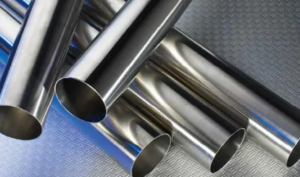Have you ever thought about the materials that are used to make many products we use in daily life, such as coffee pots, cookware, building structures, and pipelines? The answer is ferritic stainless steel. This material is not only beautiful but also very durable and has many interesting applications. In this article, let’s take a look at the applications of ferritic stainless steel and see how it has changed our lives.

Introduction to the Applications of Ferritic Stainless Steel
Due to its unique combination of properties, ferritic stainless steel has a wide range of applications. Some common applications of ferritic stainless steel include:
Applications of Ferritic Stainless Steel – 1. Automotive Exhaust Systems: Ferritic stainless steel is often used in exhaust systems due to its good heat resistance, corrosion resistance, and low cost.
Applications of Ferritic Stainless Steel – 2. Household Appliances: Ferritic stainless steel is often used in household appliances such as washing machines, dryers, and dishwashers due to its good corrosion resistance and durability.
Applications of Ferritic Stainless Steel – 3. Decorative Applications: Ferritic stainless steel is sometimes used for decorative applications due to its good appearance and corrosion resistance, such as decorative hardware and building elements.
Applications of Ferritic Stainless Steel – 4. Food Processing Equipment: Ferritic stainless steel is often used in food processing equipment due to its good corrosion resistance and ease of cleaning.
Applications of Ferritic Stainless Steel – 5. Heat Exchangers: Ferritic stainless steel is sometimes used in heat exchangers due to its good heat resistance and corrosion resistance.
Applications of Ferritic Stainless Steel – 6. Buildings and Infrastructure: Ferritic stainless steel is sometimes used in buildings and infrastructure applications such as bridges and building exteriors due to its good corrosion resistance and durability.
Overall, ferritic stainless steel is widely used in various industries and applications due to its good combination of properties, low cost, and ease of manufacturing.
Is ferritic stainless steel suitable for making kitchenware?
Ferritic stainless steel can be suitable for some kitchen utensils, but it may not be the best choice for all applications. Ferritic stainless steel has many advantages, including good corrosion resistance, heat resistance, and durability, making it suitable for some types of kitchen utensils.
For example, ferritic stainless steel may be a good choice for items such as sinks, exhaust hoods, and oven liners that require good heat resistance and corrosion resistance. It may also be suitable for some types of cooking pots and frying pans, but care should be taken to avoid acidic or salty foods, which can cause corrosion and pitting of the material.
However, ferritic stainless steel may not be the best choice for items such as knives or other cutting tools that require high hardness and edge retention. Ferritic stainless steel is usually softer than martensitic stainless steel or austenitic stainless steel and may not be able to maintain edges well for cutting applications.
Overall, whether ferritic stainless steel is suitable for kitchen utensils depends on the specific application and the performance required for the expected use. It is important to carefully consider the specific requirements and choose the appropriate grade of stainless steel for the application to ensure optimal performance and durability.
Can ferritic stainless steel be welded?
Ferritic stainless steel is weldable, but careful consideration of the welding process and parameters is required to avoid issues such as cracking. Compared to other types of stainless steel, ferritic stainless steel has a lower thermal conductivity and a higher coefficient of thermal expansion, which can lead to deformation and cracking during the welding process if the heat input is not controlled properly.
The most common welding processes for ferritic stainless steels are TIG (tungsten inert gas) welding and laser welding, as they allow precise control of heat input and minimize distortion and cracking. However, other welding processes, such as MIG (metal inert gas) welding and plasma arc welding, can also be used with appropriate precautions.
Choosing the appropriate filler metal when welding ferritic stainless steel is important as the wrong type of filler metal can lead to cracking and reduced corrosion resistance. Typically, a filler metal with a slightly higher nickel content than the base material is recommended for welding ferritic stainless steel.
To ensure the best results when welding ferritic stainless steel, it is essential to follow recommended welding procedures and parameters, and correctly prepare the weld joint to ensure clean and contaminant-free material.
Why Choose Sino Stainless Steel?
Thank you for reading our article and we hope it can help you to have a better understanding of the applications of ferritic stainless steel. If you want to find more information about stainless steel, we’d advise you to visit Sino Stainless Steel.
As a top supplier of stainless steel products across the whole world, Sino Stainless Steel provides customers with high-quality stainless steel products such as stainless steel coils, carbon steel pipes, stainless steel strips, stainless steel sheets, stainless steel wires, stainless steel tubes, and stainless steel bars at a very competitive price.
 :+86-13012867759
:+86-13012867759  :export86@sino-stainless-steel.com
:export86@sino-stainless-steel.com